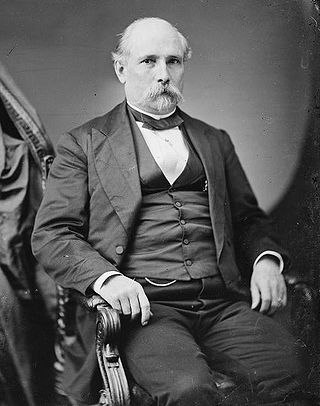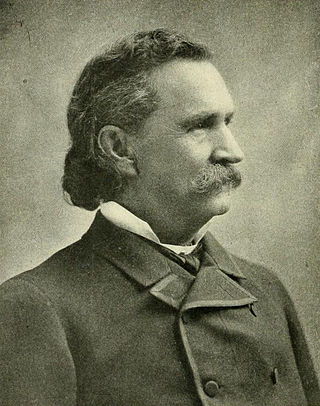
The Confederate States of America (CSA), commonly referred to as the Confederate States (C.S.), the Confederacy, or the South, was an unrecognized breakaway republic in the Southern United States that existed from February 8, 1861, to May 5, 1865. The Confederacy was composed of eleven U.S. states that declared secession; South Carolina, Mississippi, Florida, Alabama, Georgia, Louisiana, Texas, Virginia, Arkansas, Tennessee, and North Carolina; they warred against the United States during the American Civil War.

James Lusk Alcorn was a governor, and U.S. senator during the Reconstruction era in Mississippi. A Moderate Republican and Whiggish "scalawag", he engaged in a bitter rivalry with Radical Republican Adelbert Ames, who defeated him in the 1873 gubernatorial race. Alcorn was the first elected Republican governor of Mississippi.

Arizona Territory, colloquially referred to as Confederate Arizona, was an organized incorporated territory of the Confederate States of America that existed from August 1, 1861, to May 26, 1865, when the Confederate States Army Trans-Mississippi Department, commanded by General Edmund Kirby Smith, surrendered at Shreveport, Louisiana. However, after the Battle of Glorieta Pass, the Confederates had to retreat from the territory, and by July 1862, effective Confederate control of the territory had ended. Delegates to the secession convention had voted in March 1861 to secede from the New Mexico Territory and the Union, and seek to join the Confederacy. It consisted of the portion of the New Mexico Territory south of the 34th parallel, including parts of the modern states of New Mexico and Arizona. The capital was Mesilla, along the southern border. The breakaway region overlapped Arizona Territory, established by the Union government in February 1863.

The president of the Confederate States was the head of state and head of government of the Confederate States. The president was the chief executive of the federal government and commander-in-chief of the Confederate Army and Navy.

The Confederate States Congress was both the provisional and permanent legislative assembly / legislature of the Confederate States of America that existed from February 1861 to April / June 1865, during the American Civil War. Its actions were, for the most part, concerned with measures to establish a new national government for the Southern proto-state in the current Southern United States region, and to prosecute a war that had to be sustained throughout the existence of the Confederacy. At first, it met as a provisional congress both in the first capital city of Montgomery, Alabama, and the second in Richmond, Virginia. As was the case for the provisional Congress after it moved northeast to Richmond, the permanent Congress met in the existing Virginia State Capitol, a building which it also shared with the secessionist Virginia General Assembly.

The 1st Confederate States Congress, consisting of the Confederate States Senate and the Confederate States House of Representatives, convened between February 18, 1862, and February 17, 1864. This assembly took place during the first two years of Jefferson Davis's presidency, convening at the Virginia State Capitol in Richmond, Virginia.

The 2nd Confederate States Congress, consisting of the Confederate States Senate and the Confederate States House of Representatives, met from May 2, 1864, to March 18, 1865, during the last year of Jefferson Davis's presidency, at the Virginia State Capitol in Richmond, Virginia; the Confederacy's government effectively dissolved 16 days later, when it fled Richmond on April 3, 1865. Its members were elected in the 1863 congressional elections.
The Provisional Constitution of the Confederate States, formally the Constitution for the Provisional Government of the Confederate States of America, was an agreement among all seven original states in the Confederate States of America that served as its first constitution. Its drafting by a committee of twelve appointed by the Provisional Congress began on February 5, 1861. The Provisional Constitution was formally adopted on February 8. Government under this constitution was superseded by the new Constitution of the Confederate States with a permanent form of government "organized on the principles of the United States" on February 22, 1862.

Laurence Massillon Keitt was an American planter, lawyer, politician, and soldier from South Carolina. During his tenure in the United States House of Representatives, he was included in several lists of Fire-Eaters—men who adamantly urged the secession of southern states from the United States, and who resisted measures of compromise and reconciliation, leading to the American Civil War.

John Robert Baylor was a US Indian agent, publisher and editor, politician, and a senior officer of the Confederate States Army. After being dismissed as Indian agent, he became one of the founding editors of The White Man, a newspaper in North Texas, and a strong critic of Governor Sam Houston.

The 37th United States Congress was a meeting of the legislative branch of the United States federal government, consisting of the United States Senate and the United States House of Representatives. It met in Washington, D.C., from March 4, 1861, to March 4, 1863, during the first two years of Abraham Lincoln's presidency. The apportionment of seats in the House of Representatives was based on the 1850 United States census.

John Gregg was an American politician who served as a deputy from Texas to the Provisional Congress of the Confederate States from 1861 to 1862. He served as a brigade commander officer of the Confederate States Army and was killed in action during the Siege of Petersburg.

Walker Brooke was an American politician who served as a Deputy from Mississippi to the Provisional Congress of the Confederate States from 1861 to 1862. He was also a U.S. Senator from 1852 to 1853, representing the state of Mississippi.

Edward Cary Walthall was a general in the Confederate States Army during the American Civil War and a Reconstruction era United States Senator from Mississippi.
Cornelius Robinson was a politician from Alabama who served in the Provisional Confederate Congress at the beginning of the American Civil War.
The Confederate Congress created the position of Quartermaster-General on 26 February 1861 and the Secretary of War was allowed one Colonel and six Majors to serve as Quartermasters. The first Quartermaster General was Col. Abraham C. Myers; his appointment would appear to have been a foregone conclusion as he was signing himself as Acting Quartermaster General on 2 January 1861. In May 1861 when the Confederate government moved to Richmond, Virginia, the headquarters of the Quartermaster General were located on the corner of Ninth and Main Street.

This article is a list of national symbols of the Confederate States of America enacted through legislation. Upon its independence on February 8, 1861, and subsequent foundation of the permanent government on February 22, 1862, the Confederate States Congress adopted national symbols distinct from those of the United States.

















